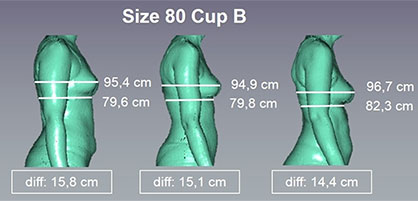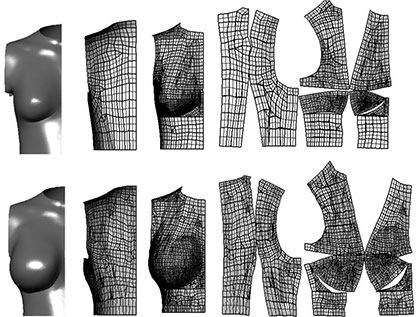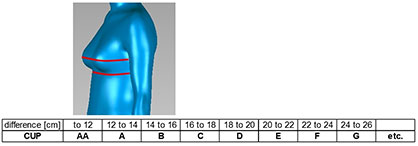Research & Development
The problems and challenges of cup sizes

Pic: In terms of measurements, all three women have the same cup size, but the volume varies. How much volume should be assigned to each cup size? © Hohenstein Gruppe
Innovative approach to optimised cup sizing
Making underwear that fits properly for women of all sizes, body types and age groups is not possible using the current cup system. Women's body shapes vary too much, especially when it comes to their breasts.
That is why the Hohenstein Institute set up a research project with the aim of developing a new system that would allow cup sizes to be determined in accordance with body shape and breast volume. The key questions to be addressed by the research project were "Which body parameters affect cup size?", "What kind of anthropometric process is required to determine cup volume reliably and accurately?" and "How can cup sizes be assigned accurately, taking account of the actual volume of the breast?". The latest 3D technologies were used in the research work.

Pic: Volume-based pattern development based on 3D scans - the new data on breast volume was converted into optimised basic patterns for use in pattern-cutting. © Hohenstein Gruppe
The results of the research are in the form of data about breast volume and new breast measurements which can be used to supplement and update existing size charts for foundation garments. Those body parameters have been described which affect the volume of the breasts, and solutions proposed for how the process of determining cup size could be improved.
The researchers also developed virtual 3D cup models for visualising cup sizes and used them to construct volume-based 3D basic patterns. The results also show the extent to which successful marketing of foundation garments depends on both the product and the target market. There can never be one standard solution that is suitable for all circumstances.

Pic: Cup size models in size 75, Cup A to B - Based on statistical analysis of breast measurements, and 3D shape analysis, researchers developed average 3D models to visualise average breast volume. © Hohenstein Gruppe
The new findings from the project describe the specific sizing requirements for foundation garments and cup-based clothing products, and constitute an important basis for further development. They will help to improve the fit of products, assist customers in finding the right size and reduce high product development costs. The virtual breast models that have been developed also provide useful fitting principles for use in 3D simulation and design systems.

Pic: Cup size is based on the difference between the circumference around and below the breasts. © Hohenstein Gruppe
Who will benefit from this innovative method of cup sizing?
A research report is available that can be obtained by any interested company. It describes the results and the basic principles which were derived from the research and need to be taken into account when developing and marketing foundation garments and cup-based clothing products. However, it is not only the manufacturers of underwear, orthopaedic items and ladies' outerwear who will benefit. It will also be to the advantage of customers themselves if the results of the research can be used to develop and market bra shapes that are more adapted to customers' body shapes. It will be easier for them to find the right size in the shops and, secondly, it will help ensure that more women wear a correctly fitting bra. The researchers hope that, in the long term, typical health problems such as skin irritation, shoulder and back problems and shoulder strain caused by badly fitting bras can be avoided.
